
An autogyro, or gyroplane, is a type of rotorcraft that uses an unpowered rotor in free autorotation to develop lift. While similar to a helicopter rotor in appearance, the autogyro's unpowered rotor disc must have air flowing upward across it to make it rotate.
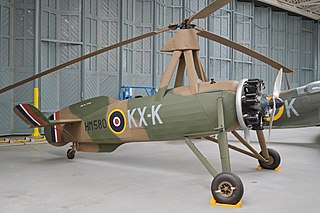
The Cierva C.30 is an autogyro designed by Juan de la Cierva and built under licence from the Cierva Autogiro Company by A V Roe & Co Ltd (Avro), Lioré-et-Olivier and Focke-Wulf.
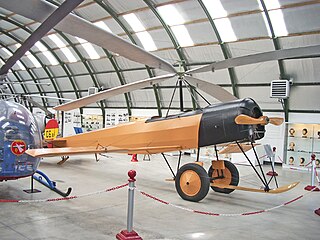
The Cierva C.6 was the sixth autogyro designed by engineer Juan de la Cierva, and the first one to travel a "major" distance. Cierva, the engineer responsible for the invention of the autogyro, had spent all his funds on the research and creation of his first five prototypes. Therefore, in 1923, he turned to the Cuatro Vientos Aerodynamics Laboratory chief, Commander Emilio Herrera, who succeeded in persuading General Francisco Echagüe, the director of the Military Aviation Aeronautics Department, to take over the second stage in the research and development of Cierva's autogyros.

The Pitcairn OP-1 was the first rotary-wing aircraft to be seriously evaluated by any of the world's major air forces. The machine was not a helicopter, nor an airplane, but an autogyro. Pitcairn's model was never put into production for any military.
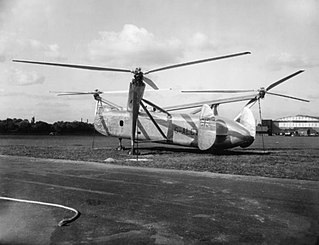
The Cierva W.11 Air Horse was a helicopter developed by the Cierva Autogiro Company in the United Kingdom during the mid-1940s. The largest helicopter in the world at the time of its debut, the Air Horse was unusual for using three rotors mounted on outriggers, and driven by a single engine mounted inside the fuselage.

The Fairey FB-1 Gyrodyne is an experimental British rotorcraft that used single lifting rotor and a tractor propeller mounted on the tip of the starboard stub wing to provide both propulsion and anti-torque reaction.
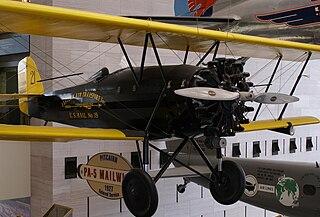
Harold Frederick Pitcairn was an American aviation inventor and pioneer. He played a key role in the development of the autogyro and founded the Autogiro Company of America. He patented a number of innovations relating to rotary wing aircraft.
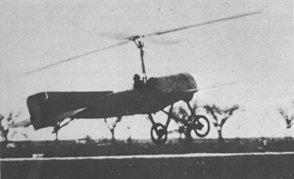
The Cierva C.4 was an experimental autogiro built by Juan de la Cierva in Spain in 1922 which early the following year became the first autogyro to fly successfully. Failures of De la Cierva's attempts to compensate for dissymmetry of lift with the C.1, C.2, and C.3 autogiros, led him to consider alternate means of enabling an autogyro to fly without rolling over. He noted that the problems experienced with his full-size aircraft were not present in the models that he had successfully flown, and considered the difference between the full-size and small-scale rotors. The rotors used on his model were made of bamboo and were thus far more flexible than the ones on his full-size aircraft. While attending an opera he realized that the flexibility eliminated the moments acting on the hub and associated instability. Trained as a civil engineer, Cierva was aware that a cantilever structure hinged to its attachment point generated no moment, and he designed a rotor the blades of which were mounted to the hub through hinges to permit their vertical oscillation.

The Cierva C.8 was an experimental autogyro built by Juan de la Cierva in England in 1926 in association with Avro. Like Cierva's earlier autogyros, the C.8s were based on existing fixed-wing aircraft fuselages – in this case, the Avro 552.

The Cierva C.19 was a 1930s British two-seat autogyro, designed by Spanish engineer Juan de la Cierva. It was built by Avro as the Avro Type 620. It proved to be the most successful and widely produced of the early de la Cierva designs.

The Cierva CR Twin was a five-seat utility helicopter that first flew in the UK in 1969. It was a joint development between Cierva Autogiro Company and Rotorcraft now a subsidiary of Cierva, based on the dynamic systems of the latter company's Grasshopper design. A new, highly streamlined pod-and-boom fuselage was married to the Grasshopper's coaxial rotor system, and the new aircraft registered G-AWRP first flew on 18 August 1969.

The Kellett KD-1 was a 1930s American autogyro built by the Kellett Autogiro Company. It had the distinction of being the first practical rotary-wing aircraft used by the United States Army and inaugurated the first scheduled air-mail service using a rotary-wing aircraft.

The Kellett K-2 was a two-seat autogyro developed in the United States in the early 1930s. Later examples were designated K-3 and K-4 when equipped with more powerful engines. K-3 NC 12691 is seen in the 1934 movie, It Happened One Night.

The Pitcairn PA-34 and Pitcairn PA-33, given the United States Navy (USN) designation Pitcairn OP-2 and United States Army designation Pitcairn YG-2 respectively were reconnaissance autogyros designed and built in 1936 for evaluation.

The Pitcairn PA-18 was an autogyro produced in the United States in the early 1930s.
The Pitcairn PA-19 was a four-seat autogyro developed in the United States in the early 1930s. While most of Pitcairn's autogyro designs featured open cockpits in tandem, the PA-19 had a fully enclosed cabin. It also had wings that carried control surfaces. The rotor provided lift only, but could be tilted in flight to trim the aircraft. Four examples were built before the effects of the Great Depression forced Pitcairn to abandon autogyro production in 1934.

The Pitcairn PCA-2 was an autogyro developed in the United States in the early 1930s. It was Harold F. Pitcairn's first autogyro design to be sold in quantity. It had a conventional design for its day – an airplane-like fuselage with two open cockpits in tandem, and an engine mounted tractor-fashion in the nose. The lift by the four-blade main rotor was augmented by stubby, low-set monoplane wings that also carried the control surfaces. The wingtips featured considerable dihedral that acted as winglets for added stability.
The Cierva C.40 was a British autogyro designed by G.B.L. Ellis, Otto Reder, and Dr. J.A.J Bennett and was assembled by the British Aircraft Manufacturing Company at London Air Park, Hanworth.

The Autogiro Company of America AC-35 was an early attempt to make a roadable aircraft in the United States during the 1930s. Although it was successfully tested, it did not enter production; a 1960s attempt to revive the aircraft in a non-roadable version also failed to achieve success.

The Pitcairn Aircraft Company was an American aircraft manufacturer of light utility aircraft. An early proponent of the autogyro, the company, later known as the Autogiro Company of America among other names, remained in business until 1948.

















